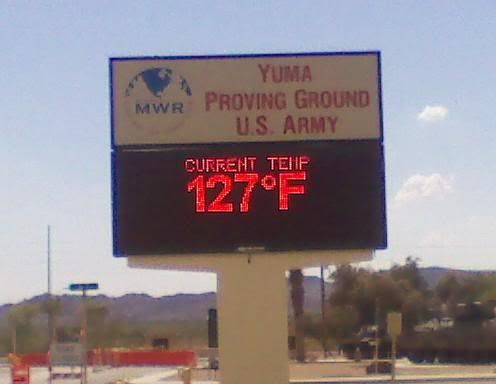stemelbow wrote:DrW wrote:So I will just thank you for your service to your country, and let you know that it never got as high as 127 while I was at Yuma (but I have seen it 130 Degrees F plus at Camp Doha in Kuwait - again while involved with M1 tanks).
-------------
by the way, if you ever have to go to battle in the the Kingdom or Kuwait, I hope it is in an M1. In the open desert, the Striker's "dash and cover" doctrine becomes highly theoretical.
Heya DrW,
many here have claimed, essentially, that if a person is caught in a lie that means they are forever to be known as a liar. I hope they are far more charitable to those who they have no bias against, like you.
In summer, average daily high temperatures range from 42 to 46 °C (107.6 to 114.8 °F); the highest ever temperature recorded in Kuwait was 53.5 °C (128.3 °F) at Kuwait International Airport on August 3, 2011.
http://en.wikipedia.org/wiki/Geography_of_KuwaitDo you currently live in Kuwait?
Hey Stem,
Sort of disappointed that you didn't at least search Google for temperatures at
Camp Doha before accusing me of being less than truthful. If you would have taken the next logical step in your quest for knowledge (e.g. Google search string =
130 degrees Camp Doha), you would have found the following on the GlobalSecurity.org website describing conditions at Camp Doha:
.... blowing sand, 130-plus degree temperatures, and <snip>
Underlining is mine. The website URL is:
http://www.globalsecurity.org/military/ops/intrinsic_action.htmI do not live in Kuwait. I have spent time there however, including lecturing at KISR and working on military offset deals for Sikorsky and Pratt & Whitney.
While I do not doubt that the highest recorded temperature at the Airport in Kuwait was 128.3 degrees F, you need to understand that official temperatures at airports are obtained on the inside of covered, vented weather stations normally located well above ground level.
Pilots are the most important consumers of airport met office data and need to know what the temperature, barometric pressure, relative humidity and wind speed and direction are in the air through which they will be making their approach. All of these factors figure into the airspeed and control surface configuration they must maintain on approach, given the gross weight of their aircraft.
Temperature, pressure and humidity determine
density altitude, and the pilot who does not have this information from the airport weather station runs the risk of premature contact with the ground. In other words, pilots and airport met stations are not that interested in conditions very close to the ground. They need to know about the air the pilots will be flying through above the ground.
If you have ever lived in a sand desert, you will understand that, on sunny days, there can be quite an air temperature gradient with increased height above the ground. The higher one goes, the cooler it is. And this gradient can become quite steep at heights below a meter or two.
So, as shown in the above passage, the outside temperatures at Camp Doha, to which many military personnel are exposed near ground level in the summer time can, and often do, exceed 130 degrees F.
And unlike Yuma, it ain't "dry" heat.
_______________
ETA: No apologies needed, Stem.
I think you are basically an honest guy and probably meant well.
